Sandmining is destroying Asia’s rivers
Uncontrolled and illegal extraction of sand and rocks from riverbeds for construction is killing rivers
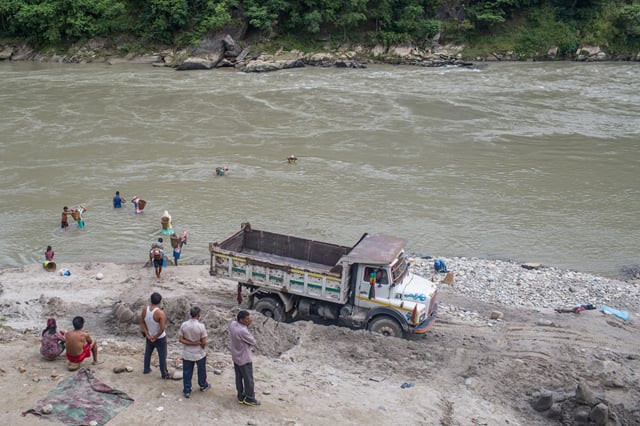
Banned in 1991, sand mining from riverbeds continues illegally in Nepal. PHOTO: Nabin Baral
Reporting illegal sand mining is the most dangerous thing a journalist can do in India. In the last couple of years, three journalists have been killed, allegedly by the illegal sand mining mafia, one each in the states of Uttar Pradesh, Madhya Pradesh and Bihar. A fourth journalist reporting on illegal mining of sand from the beaches of Tamil Nadu has been repeatedly threatened; anonymous callers – claiming to speak on behalf of a local politician from the party that rules the state – have ordered her to stay away from the area or else.
 Post monsoon sand being extracted daily out of rivers near Mangalore. PHOTO: Ashwin Kamath
Post monsoon sand being extracted daily out of rivers near Mangalore. PHOTO: Ashwin KamathApart from journalists, there was the death of the monk who opposed illegal sand mining around Hardwar, where the Ganga comes down from the Himalayas and enters the north Indian plains. The monk had been on hunger strike and had been taken to hospital, where he died. Mystery surrounds the cause of his death.
India arrests highlight impact of 'sand mining mafia' on local communities
Still, activists have continued to oppose illegal sand mining in India. The recent order by the Uttarakhand High Court declaring the Ganga and the Yamuna as living entities was in response to a petition by an activist, seeking an end to illegal sand mining around Hardwar. As part of the same order, the court banned all sand mining in the area for four months, and asked the government what it planned to do to stop illegal mining. There is no response from the authorities yet.
There was a recent raid on illegal miners in the suburbs of India’s capital New Delhi after a rash of media reports. Within hours, some morning walkers at the Okhla Bird Sanctuary along the Yamuna river were beaten up, reportedly by miners who suspected that walkers and joggers had informed the authorities about the illegal extraction.
In India, perhaps the most blatant case of illegal sand mining takes place in the lowest reaches of the Ganga, between the Farakka barrage and the confluence of the river with the Bay of Bengal. Pontoons are anchored in the middle of the river, large pumps are set up on them, and the sand is pumped up and sent to the riverbank through a pipe.
Asked about this, officials in the West Bengal state government said that the riverbed is under the jurisdiction of either local municipalities or the National Waterways Authority of India (NWAI). The mayor of Chandannagar – one of the largest municipalities along this stretch of the river – said it was the responsibility of his counterpart on the other bank. There was no official response from NWAI. Unofficially, its officials say they cannot do anything because local politicians are involved in illegal sand mining. One of them also said, “We keep quiet because extracting the sand and the silt keeps the navigation channel dredged and open.”
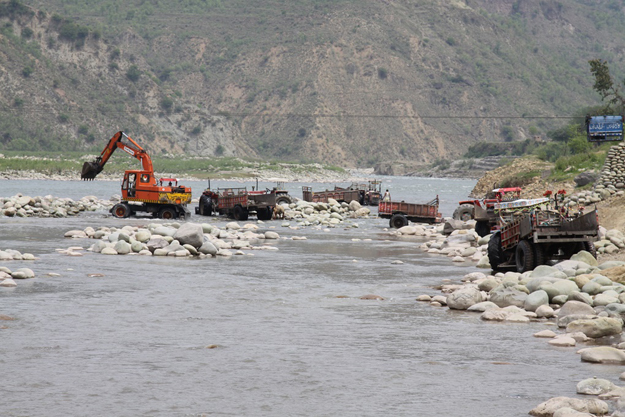 Mining in Poonch river using heavy machinery is destroying river habitats: PHOTO: Hagler Bailly Pakistan
Mining in Poonch river using heavy machinery is destroying river habitats: PHOTO: Hagler Bailly PakistanThe effects are there for all to see. Riverbank erosion has increased, to the point that one of the bridges over the Ganga has become unusable – a girder collapsed because so much sand and silt were removed around its foundations. Residents now have to take a slow ferry or a 50 kilometre detour to cross the river.
Illegal sand mining from the mountains to the sea in Pakistan
For over 12 years Nadeem Mirbahar, an ecologist and expert at the IUCN Commission on Ecosystem Management, has been watching sand and gravel being dug illegally from the bed of the Malir river that flows through parts of Karachi and the Hub river in Pakistan’s southwestern province of Balochistan.
But the government remains indifferent. “It’s an issue about which most people are not aware, not even the communities living near the riverbed create a ruckus. Therefore there no state policy or planning to control the indiscriminate excavation of the riverbeds by identifying and designating areas from where the miners can quarry the building material. That is causing a colossal ecological problem,” Mirbahar told The Third Pole.
Unauthorised Construction: Notices issued to illegal buildings
“The people along the Malir who rely on wells often complain not just of a drop in the water levels with many wells running dry, but of water quality degradation,” said Mirbahar. However, the residents do not realise sand mining is one of the main reasons. The sand acts as a filter before the water percolates into the ground, and so without the sand, water will just rush down to become flash floods downstream.
The situation is similar across the the Jhelum river (in Punjab), and the Neelum and the Kunhar rivers (in Khyber Pakhtunkhwa), according to Vaqar Zakaria, an environmental flow specialist and managing director of Hagler Bailly Pakistan, a consultancy firm.
Zakaria thinks the impact of sand mining may be less downstream in the plains, as river ecology evolves with the change in slope. However, less sediment flowing down the rivers does result in erosion of the banks and loss of fertility in irrigated areas and delta regions. Trapping of sediment in the Mangla resevoir on the Jhelum, for example, has reduced fish species downstream of the dam. Clearer waters mean the predators have a field day eating the young of other fish.
For over 12 years, Zakaria has been working in the Poonch river in the Mahaseer National Park. Its entire stretch from the Indian border to Mangla dam was declared a national park in 2010. The river has a high diversity of fish species, particularly the endangered Mahaseer (Tor putitora), which was on the IUCN Red List in 2013. Yet, says Zakaria, extensive sand and gravel mining and illegal fishing continues at several locations along the river, due to ineffective protection and management.
Sand mining and gravel extraction picks up every winter, when the water flow is low, and it is easier to mine the sand from the exposed riverbed. Nowadays, it is no longer a matter of using manual shovels and spades. Mechanised shovels and donkeys with tractors tear apart the riverbed.
Rampant illegal riverbed mining in Nepal
In 1991, the government of Nepal banned riverbed sand mining citing the collapse of a bridge on the Bagmati river in Kathmandu. But illegal sand mining is still rampant in most rivers across the country. A case study done by Tribhuvan University in 2007 said that about 40% of the total demand for sand in the Kathmandu valley was met through illegal riverbed mining. As the activities are illegal, it was hard to quantify the amount of sand being extracted, the authors of the study pointed out.
According to this and other studies, significant sand and gravel extraction from riverbeds started in the 1960s and has been increasing exponentially as the demand for construction materials rises due to rapid urbanisation.
“Most of the riverbed extraction destroys the vegetative cover of the aquatic environment and reduce the nutrient inputs into the river so its severely affects aquatic life,” said Subodh Sharma, professor at the department of environmental sciences and engineering in Kathmandu University.
Uncontrolled riverbed mining has also put bridges in danger, as riverbeds have been lowered significantly. A study done in western Nepal’s Tinau river revealed that the riverbed has been lowered by 2.5 metres in the last 15 years. “We haven’t done enough studies of the impact yet,” said Sharma. “Whatever little we have done shows that the future of our rivers is very uncertain and they have been raped. It is not a term I want to use, but I cannot find another.”
Sand mafia too strong for Bangladesh officials
In Bangladesh, illegal sand mining from rivers and wetlands is carried out with support from elected public representatives, according to local residents. Construction companies install heavy machinery in the rivers and extract sand, damaging not just the riverbed but the farms on the banks. Illegal sand extraction hastens riverbank erosion across
the Ganga-Brahmaputra-Meghna delta that makes up most of Bangladesh. The sand thus extracted is used not only for the construction industry, but also to fill in wetlands prior to laying claim over it.
Recent media reports say illegal sand mining is rampant Narayanganj, Tangail, Sirajganj, Munshiganj, Rajshahi and Manikganj districts, and almost rivers of Bangladesh – big and small – are affected. There is hardly ever any action taken against the illegal sand mining mafia, despite complaints from green activists.
Ban imposed on illegal mining, excavation
Syed Rizwana Hasan, chief executive of Bangladesh Environmental Lawyers’ Association (BELA) told The Third Pole, “Use of heavy machinery leading to indiscriminate and unscientific mining has become a cause of concern as these are changing the riverbed characteristics and exacerbating riverbank erosion. In Bangladesh, most of the sand mining from rivers is being done with the support of elected public representatives as they are not aware of the damages.”
Exporting sand
To add to this, the Bangladesh government has recently decided to start exporting sand to Maldives and Singapore, after extracting it from the bed of the Jamuna river, as the Brahmaputra is called in Bangladesh.
The decision was reportedly taken at a meeting of the National Sand Corridor Management Committee with land minister Shamsur Rahman Sharif in the chair on March 5. The ministry stated that the sand would be sold at 1 taka (about 1 US cent) per cubic feet.
China, the biggest sand market
In China, demand for sand is greater than anywhere else in the world due to rapid urbanisation. Demand for cement has increased 400% over the past two decades, according to the United Nations Environment Programme.
In the past four years, China has used more cement than the US used in the entire 20th century.
Cement manufacturing needs sand, and all that sand has to come from somewhere. In the region around Shanghai, it came until recently from the bed of the Yangtze River. By the late 1990s miners had pulled out so much that bridges were destabilised, shipping was hampered, and swaths of riverbank collapsed.
In 2000, Chinese authorities banned the activity along the lower and middle reaches of the river. This simply drove many sand miners to Poyang Lake, China’s largest freshwater body of water that flows into the Yangtze about 600 kilometres upstream of Shanghai.
NASA’s Earth Observatory released dramatic satellite images of Poyang Lake. Comparing images from 1995 and 2013, the agency showed how miners had dramatically transformed the lake.
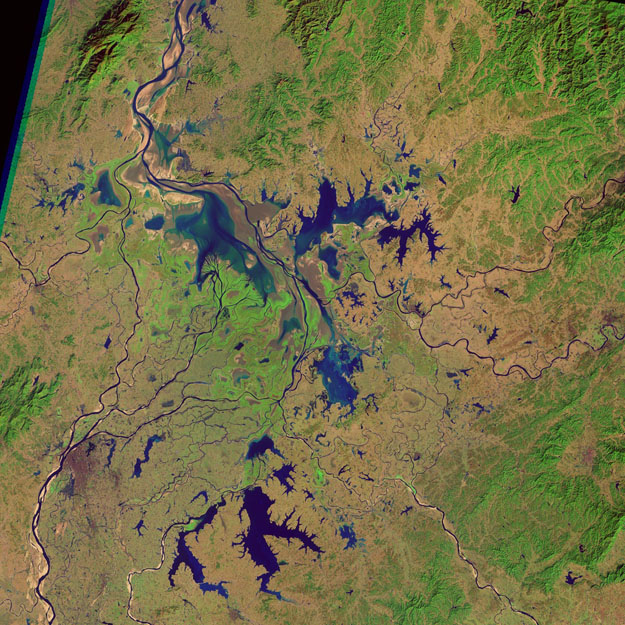 Poyang lake in 1995. PHOTO: Nasa Earth Observatory
Poyang lake in 1995. PHOTO: Nasa Earth Observatory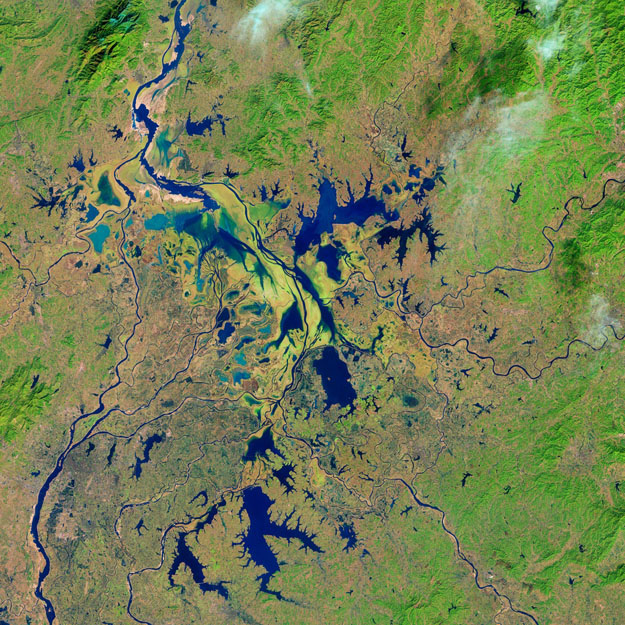 Poyang lake in 2013. PHOTO: Nasa Earth Observatory
Poyang lake in 2013. PHOTO: Nasa Earth ObservatoryA recent study estimates that 236 million cubic metres of sand are removed from the lake very year —about 9% of the total produced by China. That makes Poyang the biggest sand mine on the planet. Researchers say sand mining is the major reason why the lake’s water level has dropped dramatically in recent years. The lower water levels have led to declining water quality and supply to surrounding wetlands – Asia’s largest winter migration spot for endangered Siberian cranes and white storks.
Mekong sand
The Mekong river is another major source of sand for China’s construction industry. On the Yunnan stretch of the river, sand dredging is generally allowed with permission from county or provincial authorities, who have banned sand dredging in certain places, usually in ecological hotspots.
But there hasn’t yet been a clear assessment of how exactly sand dredging operations in Yunnan have affected the biodiversity and fish populations of the Mekong. However, the overall loss of sediment, from dredging and also held back by large dams, has visibly transformed river landscapes in countries like Vietnam, where the rich Mekong delta constitutes the region’s rice bowl.
Dredging has taken place for years along the Mekong, but the industrial scale is relatively new. On the Lower Mekong between Laos and Vietnam, 50 million tonnes of sand were extracted in 2011 alone, WWF estimates – much more than the river produces in a year.
This led the riverbed to drop by more than a metre in the delta between 1998 and 2008, allowing salt water to seep further into rice paddy fields and the entire delta to subside.
The solution
A complete ban on sand mining would have the same effect as a prohibition on alcohol or prostitution – it would only drive the industry further underground and raise house prices, as happens every time the authorities try to clamp down on the practice.
Anti-encroachment drive in Galiyat
Across the countries, all experts agree that the one practical solution is to designate stretches of rivers from which sand can be extracted – and this designation must be done on ecological principles. Contracts for mining along these stretches can be given in a transparent manner. It will enable the authorities to control the amount of sand and gravel extracted. It will also earn them royalty – they get nothing now.
Various state governments in India and national governments in other South Asian countries have such stretches where extraction of sand and gravel from the riverbed is permitted and licensed. But this system has not kept pace with the demand for construction material, and that needs to be sorted out immediately. Sri Lanka has just passed a law to regulate and have a proper mechanism to mine sand, gravel, and rocks, a law that can serve as a model for other countries in the region.
This story originally appeared on The Third Pole




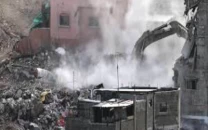







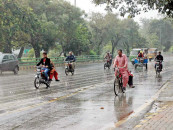






COMMENTS
Comments are moderated and generally will be posted if they are on-topic and not abusive.
For more information, please see our Comments FAQ